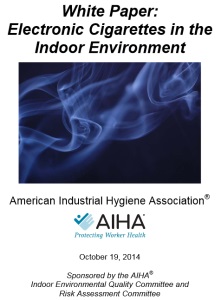
by Brianna Crandall — November 7, 2014—Since facilities owners and managers are concerned with their facilities’ indoor air quality and may make decisions on acceptable practices indoors, a new report from the American Industrial Hygiene Association (AIHA) that describes the potential exposures and health risks associated with the use of electronic cigarettes may be of interest. The report, which reviewed current scientific information and evaluated the effects of chemicals used in e-cigarettes and emitted from them, indicated that although e-cigarettes may be “safer” for the user than tobacco cigarettes, they can emit airborne contaminants that may affect both the user and people nearby.
“‘Vaping’ has been promoted as a smoking cessation tool that has no smoke,” said Cheryl (Cheri) L. Marcham, PhD, CIH, CSP, CHMM, project team leader on the white paper. “However, research indicates that emissions from vaping may contain nicotine and other contaminants whose health effects have not been thoroughly studied.”
E-cigarettes are battery-powered devices that deliver vaporized nicotine and other chemicals to users. They are frequently promoted as safer than traditional cigarettes because they do not burn tobacco. However, they have been shown to emit aerosols and several organic compounds, including nicotine, acetone, acrolein, formaldehyde, and flavoring compounds. AIHA explains the issues:
- The vapor from electronic cigarettes that contain nicotine may cause exposure for people around the users. AIHA reminds that exposure to even low levels of nicotine can increase heart rate, respiratory rate, and blood pressure. It can also cause birth defects, promote tumor growth, and affect brain development.
- Another chemical, propylene glycol, found in theatrical smoke, is commonly used in e-cigarettes as a carrier for the nicotine and the flavorings, and to create the “vapor” that is emitted. The literature reviewed indicates that exposure to theatrical fogs may contribute to asthma and other lung problems.
- Limited information is available on the health effects of exposure to aerosolized flavorings. A compound that may be safe when ingested is not automatically safe when inhaled as an aerosol, as has been seen with the use of diacetyl for buttery flavorings. Most flavorings in e-cigarettes have not been thoroughly studied for inhalation health effects.
The report recommends that healthcare providers, e-cigarette companies and distributors, and the public health community understand that e-cigarettes are not emission-free, and that limited scientific information exists on their potential health risks. Risk assessment methods that look at the costs and benefits of e-cigarettes may be more useful than quantitative health risk assessments. The researchers concluded that e-cigarettes should be considered a source of organic compounds and particulates in the indoor environment until they have been thoroughly evaluated for safety.
The only group that may benefit from the use of e-cigarettes consists of people who already smoke and who want to reduce their exposure to byproducts of combustion, according to the report. For other people, however, no clear benefits have been demonstrated, and there may be health risks, especially for vulnerable populations such as children, pregnant women, and people with cardiovascular and/or lung conditions.
The White Paper: Electronic Cigarettes in the Indoor Environment is available on the AIHA Web site.
See also FMLink’s “BOMA International adopts new policies on EV charging stations, e-cigarettes” for new policy positions the Building Owners and Managers Association (BOMA) International passed as guidance for facilities owners and managers on e-cigarettes during last February’s Winter Business Meeting.




